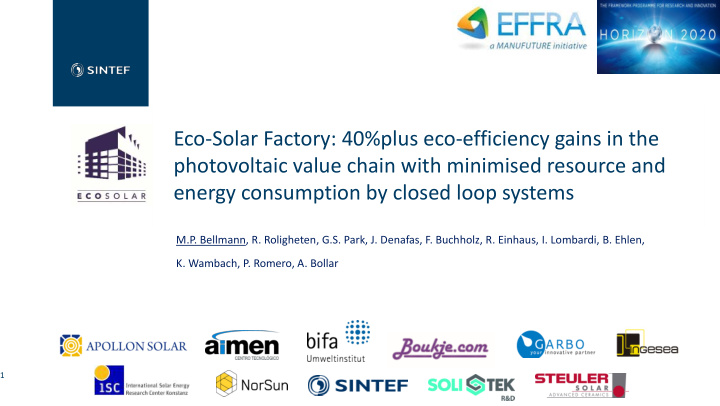



Eco-Solar Factory: 40%plus eco-efficiency gains in the photovoltaic value chain with minimised resource and energy consumption by closed loop systems M.P. Bellmann, R. Roligheten, G.S. Park, J. Denafas, F. Buchholz, R. Einhaus, I. Lombardi, B. Ehlen, K. Wambach, P. Romero, A. Bollar 1
Content • Importance of Eco-manufacturing • Strategies for enhanced process efficiency • Repurposing of waste products • Environmental impact 2
Importance of Eco-manufacturing Market outlook for the next decades: cumulative installed capacity worldwide based on different scenarios *The evolution of PV waste in Europe, May 2013, Sandt Consulting and European Centre for the Recycling of Solar Energy (CERES). Photo: [PVCYCLE] 3
Importance of Eco-manufacturing Expected resource consumption and savings by 2030 (in Megatonnes). (Note: worldwide silver resources in 2014 belong to 0.52 Mt.) *Assumptions: high-ren scenario, market 100% c-Si, no technological improvements from today to 2030 4
General approach • Maximising resource and process efficiency • Introducing design for repair, reuse and recycling 5
Eco-Solar roadmap 6
Recovery & reuse during Si-ingot crystallisation Argon purge gas recycling Reusable crucibles based on advanced Si 3 N 4 ceramics • 3-5 million m 3 of argon are used per • Silica crucibles can be only used once (cracks after usage (a)) 1GWp of silicon wafer output • Up to ~30% to the conversion from poly-Si • Recycling systems from the Semicon- to the as-grown ingot industry to refined and expanisve • Objective: > 10 x reuse for Cz and DS • Alternative solutions based on chemical looping combustion • Objective: Recycling rate > 95% 7
Recovery & reuse of Si-kerf-loss Treatment of spent Fixed Abrasive Sawing (FAS) slurry • Only the coolant is recycled by today Si-granules sc-Si • Separated Si-kerf-loss is landfilled or used as low grade alloying compound Si-powder mc-Si in foundry applications • No value at the moment is extracted from this material • Objective: reduction of Si-waste by 80% due to reutilization as Si- Si-pellets feedstock or other high end markets 8 Anode material in Lithium Ion batteries
Remanufacturing & resource efficiency in cell processing Silver Cell-doctor • Solar cell architectures • Interconnection schemes • Metallization pastes that contain less silver • Objective: 66% savings of silver Current solar cell design DI-Water • de-ionised water is used in several cleaning steps 9 • Objective: 90% recycling rate
Module design for remanufacturing (NICE) Disassembly "end-of-life" modules for recovery of module components Organics • EVA for encapsulation • PVF in backsheets • 90% less organics Aluminum • frameless module • 60% less aluminium 10
REPURPOSING OF WASTE PRODUCTS Ceramic tiles High pure graphite Living Lab – Establishment of Pan Industrial Material Reuse Opportunities Steel wires Glass Broken cells 11
Environmental impact Preliminary LCI baseline of the module production Carbon footprint *D. Yue et al., Domestic and overseas manufacturing scenarios of silicon-based photovoltaics: Life cycle energy and environmental comparative analysis, Solar Energy 105:669, 2014. 12
Technology for a better society This project has received funding from the European Union’s Horizon 2020 research and innovation programme under grant agreement No. 679692. E-mail: Martin.Bellmann@sintef.no
Recommend
More recommend